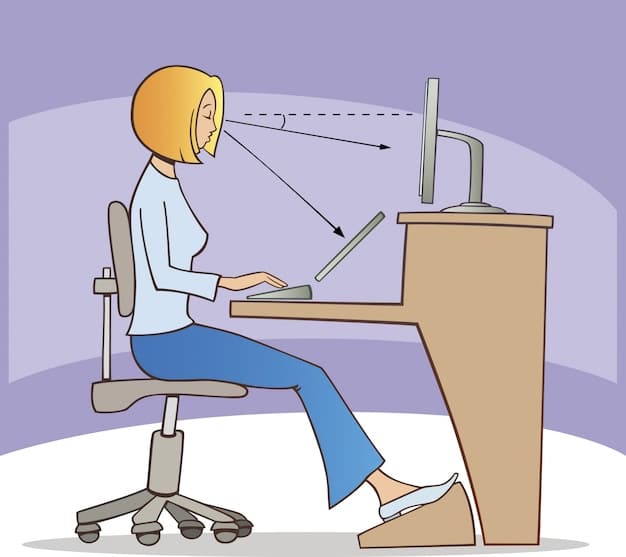Fix Your Posture: A 5-Minute Solution for Back Pain Relief

Poor posture can significantly impact your well-being, leading to back pain and other health issues; however, correcting it is possible with a simple 5-minute routine that can provide up to a 15% improvement in back pain.
Is your posture sabotaging your well-being? A simple 5-minute fix for a 15% improvement in back pain might be all you need to alleviate discomfort and boost your overall health. Let’s explore how easy it is to correct your posture and the benefits you’ll gain.
Understanding the Impact of Bad Posture
Poor posture isn’t just about aesthetics; it’s a significant contributor to various health problems. Understanding the far-reaching effects of slouching and incorrect alignment is the first step toward making positive changes.
Health Problems Caused by Poor Posture
Bad posture can lead to many physical ailments, affecting everything from your muscles to your internal organs. Here are some issues to consider:
- Back and Neck Pain: The most common complaints associated with bad posture involve chronic pain in the back and neck.
- Headaches: Poor alignment can cause tension headaches due to strained neck muscles.
- Reduced Lung Capacity: Slouching compresses the chest cavity, restricting lung function and reducing oxygen intake.
- Digestive Issues: Poor posture can compress abdominal organs, leading to digestive problems like constipation and acid reflux.
The Psychological Impact of Posture
Posture not only affects your physical health but also your mental and emotional state. Studies indicate that good posture can improve your mood and reduce feelings of stress and anxiety.
Maintaining an upright posture has been shown to increase confidence and boost self-esteem. It can also influence how others perceive you, projecting an image of competence and assurance.

The 5-Minute Posture Fix: A Step-by-Step Guide
Improving your posture doesn’t require hours at the gym or expensive equipment. A simple 5-minute routine, when practiced daily, can make a substantial difference in your comfort and well-being. Here’s how to get started.
Step 1: Chin Tucks
The chin tuck is a simple exercise that helps correct forward head posture, a common issue resulting from prolonged screen time.
To perform a chin tuck, gently pull your head back, aligning your ears with your shoulders. Hold for a few seconds and repeat 10-15 times. This exercise strengthens the neck muscles and promotes proper head alignment.
Step 2: Shoulder Blade Squeezes
Shoulder blade squeezes can counteract the rounded shoulders that typically accompany poor posture. This exercise helps open up the chest and strengthen the muscles in your upper back.
- Sit or stand with your arms relaxed at your sides.
- Squeeze your shoulder blades together as if you’re trying to hold a pencil between them.
- Hold for a few seconds and repeat 10-15 times.
Step 3: Chest Stretches
Tight chest muscles can pull your shoulders forward, contributing to poor posture. Stretching these muscles can help restore balance and improve your alignment.
A simple chest stretch involves placing your hands behind your head and gently pulling your elbows back. You can also stretch your chest by placing your forearm against a door frame and gently leaning forward. Hold each stretch for 20-30 seconds.
Integrating Posture Correction into Your Daily Routine
Making small adjustments to your daily habits can significantly impact your posture. It’s not about making massive changes but rather about being mindful of your body alignment throughout the day.
Ergonomic Adjustments at Work
Your workstation can be a prime culprit in promoting poor posture. Making a few ergonomic adjustments can greatly reduce strain and encourage better alignment.
- Monitor Height: Position your monitor at eye level to prevent slouching.
- Chair Support: Use a chair with good lumbar support to maintain the natural curve of your spine.
- Keyboard Placement: Keep your keyboard close to your body to avoid reaching and rounding your shoulders.
Mindful Posture During Activities
Being aware of your posture during everyday activities is essential for maintaining good alignment. Whether you’re walking, reading, or using your phone, try to keep your posture in mind.
When walking, stand tall with your shoulders back and your head up. While reading or using your phone, avoid hunching over and try to keep the device at eye level. These small adjustments can prevent unnecessary strain and promote better posture throughout the day.

The Long-Term Benefits of Good Posture
Investing in good posture yields numerous long-term benefits beyond immediate pain relief. Proper alignment can lead to increased energy levels, improved athletic performance, and reduced risk of chronic health problems.
Enhanced Physical Performance
Good posture allows your body to move more efficiently, improving balance, coordination, and overall physical performance. Proper alignment reduces unnecessary strain on your muscles and joints, allowing you to perform activities with greater ease and less fatigue.
Athletes often focus on posture to optimize their movements and prevent injuries. Whether you’re running, swimming, or lifting weights, good posture is essential for maximizing your performance and minimizing your risk of developing pain.
Prevention of Chronic Issues
Maintaining good posture can help prevent chronic conditions such as arthritis, disc degeneration, and nerve compression. Proper alignment reduces stress on the spine and joints, promoting long-term joint health.
By practicing good posture, you can protect your body from the cumulative effects of strain and misalignment, reducing your likelihood of developing chronic problems as you age.
Common Misconceptions About Posture
There are several misconceptions about posture that can hinder your efforts to improve your alignment. Understanding the facts can help you avoid common mistakes and achieve better results.
Myth: Perfect Posture Is Static
One common misconception is that good posture involves rigidly holding your body in a specific position. In reality, good posture is dynamic and adapts to your movements and activities.
Instead of trying to maintain a fixed posture, focus on maintaining a balanced and aligned posture that allows you to move freely and comfortably. Good posture should feel natural, not forced.
Myth: Only Certain People Need to Worry About Posture
Another misconception is that posture is only important for certain individuals, such as athletes or those with desk jobs. In reality, posture is essential for everyone, regardless of their lifestyle or occupation.
Good posture affects your overall health and well-being, influencing everything from your energy levels to your mood. Making posture a priority can benefit anyone, regardless of their physical condition or daily activities.
Tools and Resources for Posture Improvement
There are numerous tools and resources available to help you improve your posture. From posture correctors to mobile apps, these aids can provide support and feedback to help you achieve better alignment.
Posture Correctors
Posture correctors are wearable devices designed to support your back and shoulders, encouraging proper alignment. These devices can be particularly helpful if you struggle with slouching or hunching over.
While posture correctors can provide temporary support, it’s essential to use them in conjunction with exercises and lifestyle adjustments. Relying solely on posture correctors can weaken your muscles over time, making it harder to maintain good posture independently.
Mobile Apps
Several mobile apps can help you track your posture and provide feedback in real-time. These apps use your phone’s sensors to detect slouching and alert you to correct your alignment.
Posture apps can be a valuable tool for raising awareness of your postural habits and making positive changes. Look for apps that offer personalized exercises and tips tailored to your specific needs and goals.
| Key Point | Brief Description |
|---|---|
| 💪 Daily 5-Minute Fix | Simple exercises like chin tucks and shoulder blade squeezes. |
| 🖥️ Ergonomic Adjustments | Optimize your workstation for better alignment and comfort. |
| 🧘 Mindful Awareness | Be conscious of posture during daily activities. |
| ✅ Long-Term Benefits | Improved energy, reduced pain, and chronic issue prevention. |
FAQ
▼
Many people notice immediate relief in discomfort and improved energy levels within a week of consistent posture correction exercises. Long-term benefits, such as reduced chronic pain, may take several months to fully realize.
▼
Yes, poor posture can significantly impact your breathing. Slouching compresses your chest cavity, which restricts the lungs’ ability to fully expand. This can lead to reduced oxygen intake and feelings of breathlessness.
▼
Maintain good posture by ensuring your monitor is at eye level, using a chair with lumbar support, and keeping your feet flat on the floor or a footrest. Take frequent breaks to stretch and move around.
▼
Posture correctors can be helpful as a temporary aid, but they should not be relied upon as a long-term solution. It’s essential to combine their use with exercises and lifestyle adjustments to strengthen your muscles.
▼
Ideally, you should perform posture-correcting exercises daily for the best results. Even a few minutes a day can lead to significant improvements over time. Consistency is key to building muscle memory and maintaining good posture.
Conclusion
Addressing poor posture is a vital step toward improving your overall well-being. By incorporating simple exercises, ergonomic adjustments, and mindful awareness into your daily routine, you can alleviate back pain and enhance your quality of life. Start with the suggested 5-minute fix and experience the transformative benefits of good posture.





